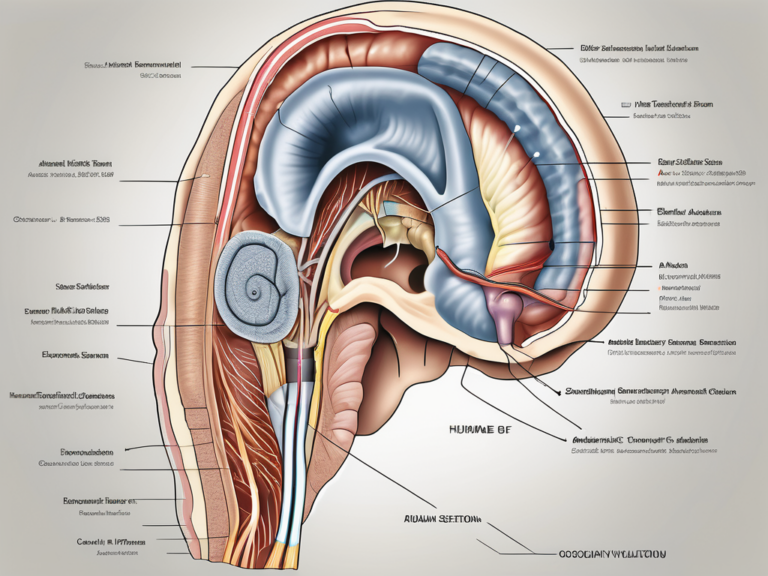The Ultimate Guide to Ear Anatomy and Function
The human ear is a marvel of design and engineering. It allows us to perceive and interpret the sounds of the world around us, providing us with an invaluable sense for communication, enjoyment, and safety. In this comprehensive guide, we will delve deep into the intricate workings of the ear, exploring its structure, function, common conditions, and methods for care and maintenance.
Understanding the Ear
The first step in understanding the ear is to explore its structure and function. The ear can be divided into three main parts: the outer ear, the middle ear, and the inner ear. Each part plays a crucial role in the process of hearing.
The outer ear consists of the pinna, or the external part that we commonly refer to as our ear. It acts as a funnel, catching sound waves and directing them into the ear canal. The ear canal, in turn, carries the sound waves to the middle ear.
In the middle ear, you will find the eardrum and three tiny bones called the ossicles. These bones, known as the hammer, anvil, and stirrup, work together to amplify the sound waves and transmit them to the inner ear.
The inner ear is where the magic happens. It contains the cochlea, a spiral-shaped structure responsible for converting sound vibrations into electrical signals that can be interpreted by the brain. The inner ear also plays a crucial role in maintaining our sense of balance and spatial awareness.
Now, let’s delve deeper into the fascinating world of the outer ear. The pinna, with its unique shape and contours, not only helps us in collecting sound waves but also plays a significant role in sound localization. This means that the position of our ears allows us to determine the direction from which a sound is coming. It’s like having built-in GPS for sound!
As we move into the middle ear, we encounter the eardrum, a thin, delicate membrane that vibrates in response to sound waves. This remarkable structure is incredibly sensitive and can detect even the slightest variations in air pressure. The eardrum’s ability to vibrate is essential for transmitting sound to the inner ear, where the real magic happens.
Speaking of magic, let’s explore the inner ear a bit further. The cochlea, nestled within the inner ear, is a truly remarkable organ. Its spiral shape is not just for aesthetics; it serves a vital purpose. The cochlea is filled with fluid and lined with thousands of tiny hair cells. When sound vibrations reach the cochlea, these hair cells move, triggering electrical signals that travel to the brain. It’s like a symphony of microscopic dancers, each playing their part to bring sound to life within us.
But the inner ear’s talents don’t end there. It also plays a crucial role in our sense of balance and spatial awareness. Deep within the labyrinth of the inner ear lies the vestibular system, which consists of three semicircular canals and two tiny sacs called the utricle and saccule. These structures work together to provide us with a constant sense of equilibrium, allowing us to navigate the world with grace and precision.
The Function of the Ear
The main purpose of the ear is, of course, to allow us to hear sound. When sound waves enter the ear, they travel from the outer ear to the middle ear and finally to the inner ear, where they are converted into electrical signals and transmitted to the brain.
But the function of the ear goes beyond just hearing. It also plays a vital role in our sense of balance and spatial orientation. The inner ear contains structures called semicircular canals, which are filled with fluid and tiny hair-like cells that detect rotational movement. This information is then sent to the brain, helping us maintain our balance and coordinate our movements.
Furthermore, the ear serves as a filter, allowing us to focus on specific sounds while ignoring others. This ability, known as auditory selective attention, enables us to listen and communicate effectively even in noisy environments.
Let’s delve deeper into the fascinating process of sound transmission within the ear. Once sound waves reach the middle ear, they encounter the eardrum, a thin, delicate membrane that vibrates in response to the sound. These vibrations are then transferred to three tiny bones called the ossicles: the malleus (hammer), incus (anvil), and stapes (stirrup). These bones amplify the vibrations and transmit them to the inner ear.
Inside the inner ear, we find the cochlea, a spiral-shaped structure filled with fluid and lined with thousands of microscopic hair cells. These hair cells are responsible for converting the mechanical vibrations into electrical signals that can be understood by the brain. Each hair cell is tuned to a specific frequency, allowing us to perceive different pitches of sound.
It’s truly remarkable how the ear can distinguish between various sounds and interpret them as meaningful information. The auditory system in the brain receives these electrical signals from the inner ear and processes them into recognizable sounds. This complex process involves the integration of different brain regions, allowing us to not only hear but also comprehend and interpret the world around us.
The Anatomy of the Ear
Now that we have a general understanding of how the ear functions, let’s take a closer look at its anatomy. By familiarizing ourselves with the location and function of each part, we can better appreciate the complexity of this remarkable sensory organ.
As mentioned earlier, the outer ear consists of the pinna, or the external ear, and the ear canal. The pinna serves to collect sound waves and direct them into the ear canal, which leads to the middle ear.
In the middle ear, we find the eardrum, a thin membrane that vibrates in response to sound waves. Behind the eardrum are the three small bones: the hammer, anvil, and stirrup. These bones amplify the sound and pass it on to the inner ear.
The inner ear is housed within the temporal bone, the bony structure of the skull. Inside the inner ear, we find the cochlea, a coiled tube filled with fluid and lined with tiny hair cells. These hair cells are responsible for translating sound vibrations into electrical signals that can be understood by the brain.
Surrounding the cochlea are the semicircular canals, which are responsible for our sense of balance. These canals detect changes in head position and movement and send signals to the brain to help us maintain our equilibrium.
Now, let’s delve deeper into the fascinating world of the cochlea. This remarkable structure is not just a simple coiled tube; it is a complex organ that plays a crucial role in our ability to hear and interpret sounds.
Within the cochlea, the fluid-filled tube is divided into three chambers. The upper chamber, known as the scala vestibuli, is connected to the oval window, a membrane that separates the middle ear from the inner ear. When sound waves enter the ear canal and cause the eardrum to vibrate, these vibrations are transmitted through the hammer, anvil, and stirrup bones, ultimately reaching the oval window. The oval window then sends these vibrations into the scala vestibuli, setting the stage for an intricate process of sound perception.
As the vibrations travel through the scala vestibuli, they encounter a second chamber called the scala media. This chamber contains the organ of Corti, a structure that houses the all-important hair cells responsible for our hearing. These hair cells are arranged in rows along the length of the cochlea, with each row tuned to a specific frequency of sound. When the vibrations reach the organ of Corti, they cause the hair cells to bend, triggering the release of neurotransmitters that stimulate nearby auditory nerve fibers. These fibers then carry the electrical signals generated by the hair cells to the brain, where they are interpreted as sound.
Finally, the vibrations continue their journey through the cochlea, reaching the third chamber called the scala tympani. From here, they exit the cochlea through the round window, another membrane that acts as a pressure relief valve, allowing the fluid within the cochlea to move freely.
So, as we explore the intricate anatomy of the ear, we begin to unravel the remarkable mechanisms that enable us to perceive and interpret the world of sound. From the outer ear to the inner ear, from the pinna to the cochlea, each component plays a vital role in our ability to hear and appreciate the symphony of life that surrounds us.
Common Ear Conditions and Disorders
Unfortunately, like any part of our body, the ear is susceptible to various conditions and disorders. Understanding these common issues can help us recognize the symptoms and seek appropriate treatment in a timely manner.
One of the most prevalent ear conditions is otitis media, commonly known as a middle ear infection. This occurs when the middle ear becomes inflamed, often as a result of a respiratory infection or allergies. Symptoms include ear pain, fluid drainage, and hearing difficulties.
Tinnitus is another common condition, characterized by a persistent ringing or buzzing sound in the ears. It can be caused by exposure to loud noise, age-related hearing loss, or certain medications. While tinnitus is not usually a sign of a serious underlying condition, it can be disruptive and affect our quality of life.
Recognizing Symptoms of Common Ear Conditions
In addition to understanding the common ear conditions, it is essential to recognize their symptoms. This knowledge can help us differentiate between a minor issue and a potentially more severe problem that requires medical attention.
If you experience sudden or severe ear pain, a loss of hearing, or a feeling of fullness or pressure in the ear, it may indicate a more significant problem, such as an ear infection or a blockage in the ear canal.
Tinnitus, as mentioned earlier, presents itself as a persistent ringing or buzzing sound in the ears. It can be accompanied by dizziness, headache, or difficulty concentrating. If these symptoms persist or worsen, it is advisable to seek medical advice.
Diagnostic Tests for Evaluating Ear Health
When it comes to evaluating ear health and diagnosing specific conditions, healthcare professionals may employ various diagnostic tests. These tests help identify the underlying cause of symptoms and guide appropriate treatment.
One common test is the audiological evaluation, which measures your hearing ability. This can involve pure-tone testing, speech testing, and tympanometry, among other techniques. These tests provide valuable information about the extent and nature of any hearing loss.
In cases where a more detailed examination of the ear’s structure is necessary, imaging tests such as X-rays, CT scans, or MRI scans may be utilized. These imaging techniques can provide detailed images of the ear’s anatomy, allowing healthcare professionals to identify any abnormalities or structural issues.
Another diagnostic test that may be used is the otoacoustic emissions (OAE) test. This test measures the sounds that the inner ear produces in response to a stimulus. It can help determine if there is damage to the hair cells in the cochlea, which can be a cause of hearing loss.
In some cases, a tympanogram may be performed to assess the movement of the eardrum and the middle ear pressure. This test can help identify conditions such as eustachian tube dysfunction or a perforated eardrum.
Overall, these diagnostic tests play a crucial role in evaluating ear health and providing healthcare professionals with the necessary information to develop an appropriate treatment plan. By understanding the symptoms and undergoing these tests, individuals can take proactive steps towards maintaining their ear health and addressing any potential issues.
Caring for Your Ears
Now that we have explored the fascinating world of ear anatomy and common conditions, it’s time to discuss essential tips for ensuring optimal ear care and maintenance.
First and foremost, it is crucial to protect your ears from excessive noise. Prolonged exposure to loud sounds can damage the delicate hair cells in the inner ear, leading to permanent hearing loss or tinnitus. Whenever possible, use ear protection such as earplugs or earmuffs when in noisy environments.
Another important aspect of ear care is maintaining proper ear hygiene. It is generally recommended to avoid inserting objects like cotton swabs or hairpins into the ear canal, as this can damage the eardrum or push earwax further into the ear. Instead, clean the outer ear gently with a damp cloth.
If you are prone to ear infections or wax build-up, consulting a healthcare professional for regular ear cleanings can be beneficial. They have the expertise to safely remove excess earwax or debris and ensure the health of your ears.
Essential Tips for Ear Care and Maintenance
In addition to the general ear care practices mentioned above, there are several additional tips that can help maintain the health and function of your ears.
Avoid using cotton swabs or other objects to clean your ears. Not only can these cause damage, but they can also push wax further into the ear canal, leading to blockages and discomfort.
If you swim frequently, wearing earplugs can help prevent water from entering the ear canal. Excess moisture can create a favorable environment for bacterial growth and potentially result in swimmer’s ear or other ear infections.
Lastly, it is important to prioritize regular check-ups with an audiologist or healthcare professional who specializes in ear health. They can assess your hearing, identify any early signs of hearing loss, and provide guidance on the best ways to protect your ears.
The Ultimate Guide to Ear Anatomy and Function: Conclusion
In conclusion, the ear is an incredibly intricate and essential organ. Its structure and function allow us to experience the world through sound, maintain our balance, and communicate effectively. Understanding the anatomy of the ear, recognizing common conditions and symptoms, and implementing proper care and maintenance practices are all crucial for our ear health and overall well-being. By following the tips outlined in this guide, you can ensure that your ears remain healthy and functional for years to come.
As you prioritize the health and functionality of your ears, consider the broader scope of your body’s well-being. The Vagus Nerve Stimulator by Vagus.net complements your ear care routine by enhancing your overall health. This innovative device is designed to rewind your autonomic clock, activating your nervous system to help you manage stress, improve your sleep, and lead a more balanced life. Experience the benefits of our advanced tVNS technology with precise, current-controlled stimulation levels for a happier, healthier you. Ready to take the next step towards optimal well-being? Buy Now and embrace a life of reduced stress, better sleep, and improved health.






